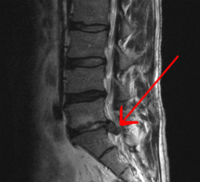
Photo from wikipedia
Objective This was a prospective controlled study with lumbar degenerative disc disease patients submitted to instrumented anterior lumbar interbody fusion (ALIF) combined with posterior stabilization. Methods A sample with 64… Click to show full abstract
Objective This was a prospective controlled study with lumbar degenerative disc disease patients submitted to instrumented anterior lumbar interbody fusion (ALIF) combined with posterior stabilization. Methods A sample with 64 consecutive patients was operated by the same surgeons over 4 years. Half of the ALIFs occurred at 2 levels, 43.8% at 3 levels, and 6.25% at 1 level. Interbody cages with integrated screws, filled with bone matrix and bone morphogenetic protein 2, were used. Results Half of the patients had undergone previous lumbar spine surgeries, 75% presented with associated degenerative listhesis, and 62.5% had posterior lumbar compression disease. Approximately 56% of the sample had at least 1 risk factor for nonunion. The Oswestry index changed from 71.81 ± 7.22 at the preoperative assessment to 24.75 ± 7.82 at the final follow-up evaluation, while the visual analogue pain scale changed from 7.88 ± 0.70 to 2.44 ± 0.87 ( p < 0.001). Clinical and functional improvements increased with the number of operated levels, proving the efficacy of multilevel ALIF, performed in 93.75% of the sample. The global complication rate was of 7.82%, with no major complications. No cases of nonunion were observed. Conclusion Instrumented ALIF combined with posterior stabilization is a successful option for uni- and multilevel degenerative disc disease of the L3 to S1 segments, even in the significant presence of risk factors for nonunion and of previous lumbar surgeries, assuring very satisfactory clinical-functional and radiographic outcomes with a low medium-term complication rate.
Journal Title: Revista Brasileira de Ortopedia
Year Published: 2019
Link to full text (if available)
Share on Social Media: Sign Up to like & get
recommendations!